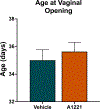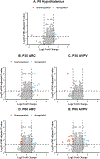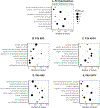Transcriptomic analysis of effects of developmental PCB exposure in the hypothalamus of female rats
- PMID: 39798907
- PMCID: PMC12054745
- DOI: 10.1016/j.mce.2025.112460
Transcriptomic analysis of effects of developmental PCB exposure in the hypothalamus of female rats
Abstract
This study investigated the consequences of perinatal exposure to Aroclor 1221 (A1221), a weakly estrogenic polychlorinated biphenyl (PCB) mixture and known endocrine-disrupting chemical (EDC), in female rats. Previous work has shown behavioral and physiological effects of A1221, and the current study extended this work to comprehensive transcriptomic profiling of two hypothalamic regions involved in the control of reproduction: the arcuate nucleus (ARC) and anteroventral periventricular nucleus (AVPV). Female Sprague-Dawley rats were fed a cookie treated with a small volume of A1221 (1 mg/kg) or vehicle (3% DMSO in sesame oil) during pregnancy from gestational days 8-18 and after birth from postnatal (P) days 1-21, exposing the offspring via placental and lactational transfer. In female offspring, developmental, physiological, and hormonal effects of A1221 were relatively modest. However, because prior work has implicated this exposure in neurobehavioral disruptions, we sought to determine whether developmental programming of the brain transcriptome could underlie these latter phenotypes. We used 3' targeted RNA sequencing in the hypothalamus (arcuate nucleus, anteroventral periventricular nucleus) of experimental females at P8, 30, and 60 and identified significant alterations in gene expression and gene ontology (GO) terms in an age- and tissue-specific manner. Most notably, terms related to synaptic signaling, neurotransmitter regulation, immune response, and cellular structure were identified. Changes in pathways associated with synaptic functions and cellular metabolism were further identified, indicating that A1221 exposure can impact neurodevelopmental and neuroendocrine processes at a molecular level, even in the absence of overt developmental changes. These findings of molecular reprogramming may explain the behavioral effects of A1221 and highlight novel molecular targets and pathways that warrant further investigation to understand the effects of EDCs on the developing brain.
Keywords: Anteroventral periventricular nucleus (AVPV); Arcuate nucleus (ARC); Aroclor 1221; Endocrine-disrupting chemical (EDC); PCB; Transcriptomics.
Copyright © 2025 The Authors. Published by Elsevier B.V. All rights reserved.
Conflict of interest statement
Declaration of competing interest The authors declare the following financial interests/personal relationships which may be considered as potential competing interests: Andrea C Gore reports financial support was provided by National Institute of Environmental Health Sciences. Andrea C Gore reports a relationship with Endocrine Society that includes: board membership. Andrea C Gore reports a relationship with Friedman Rubin LLC that includes: paid expert testimony. If there are other authors, they declare that they have no known competing financial interests or personal relationships that could have appeared to influence the work reported in this paper.
Figures






Similar articles
-
Transgenerational effects of polychlorinated biphenyls: 2. Hypothalamic gene expression in rats†.Biol Reprod. 2021 Sep 14;105(3):690-704. doi: 10.1093/biolre/ioab066. Biol Reprod. 2021. PMID: 33824955 Free PMC article.
-
Disruption of reproductive aging in female and male rats by gestational exposure to estrogenic endocrine disruptors.Endocrinology. 2013 Jun;154(6):2129-43. doi: 10.1210/en.2012-2123. Epub 2013 Apr 16. Endocrinology. 2013. PMID: 23592748 Free PMC article.
-
Dynamic postnatal developmental and sex-specific neuroendocrine effects of prenatal polychlorinated biphenyls in rats.Mol Endocrinol. 2014 Jan;28(1):99-115. doi: 10.1210/me.2013-1270. Epub 2013 Jan 1. Mol Endocrinol. 2014. PMID: 24284824 Free PMC article.
-
Early developmental actions of endocrine disruptors on the hypothalamus, hippocampus, and cerebral cortex.J Toxicol Environ Health B Crit Rev. 2011;14(5-7):328-45. doi: 10.1080/10937404.2011.578556. J Toxicol Environ Health B Crit Rev. 2011. PMID: 21790315 Free PMC article. Review.
-
Endocrine-Disrupting Chemicals, Hypothalamic Inflammation and Reproductive Outcomes: A Review of the Literature.Int J Mol Sci. 2024 Oct 22;25(21):11344. doi: 10.3390/ijms252111344. Int J Mol Sci. 2024. PMID: 39518897 Free PMC article. Review.
References
-
- Andrews S, 2015. A quality control tool for high throughput sequence data. Available online: http://www.bioinformatics.babraham.ac.uk/projects/fastqc/.
-
- Ashburner M, Ball CA, Blake JA, Botstein D, Butler H, Cherry JM, Davis AP, Dolinski K, Dwight SS, Eppig JT, Harris MA, Hill DP, Issel-Tarver L, Kasarskis A, Lewis S, Matese JC, Richardson JE, Ringwald M, Rubin GM, Sherlock G, 2000. Gene ontology: tool for the unification of biology. Nat. Genet 25 (1), 25–29. 10.1038/75556. - DOI - PMC - PubMed
MeSH terms
Substances
Grants and funding
LinkOut - more resources
Full Text Sources

